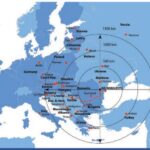Mounting evidence shows that Turkey is deploying “Syrian National Army” (SNA) militiamen to Libya by using commercial airlines. In December 2019, major media outlets broke the news that Ankara plans to send SNA militants to reinforce the “Government of National Accord” (GNA). Since then, there has been a growing number of indicators and reports that confirm the deployment. In addition to the SNA personnel, Turkey is also in the process of dispatching regular troops to Libya.
BACKGROUND: THE LIBYAN CIVIL WAR
Since the overthrow of dictator Qaddafi in 2011, Libya has been experiencing a civil war between the GNA, which is recognized by the United Nations (UN), and the self-styled “Libyan National Army” led by renegade Gen. Khalifa Haftar. The GNA currently controls less than 20 percent of Libya, but its territory includes the capital Tripoli and the densely populated Tripolitania region. The GNA’s armed forces consist of Islamist militias linked to the Muslim Brotherhood. They are backed by Turkey, Qatar and Italy.
Led by Gen. Haftar, the LNA is a hotpotch of Arab nationalists (including some Qaddafi loyalists), foreign paramilitary units (e.g. Russian, Sudanese, Chiadian), Madkhali salafists and tribal militias based in Eastern Libya. The LNA receives political and military support from Egypt, the United Arab Emirates (UAE), the Kingdom of Saudi Arabia (KSA), Jordan, Russia and France. The LNA controls the vast majority of Libya’s territory, including the oil-rich southern and central regions.
Despite the international arms embargo, which bans all weapons transfers to Libya (UN Resolution 1973), the GNA and LNA have received an abundance of military capabilities from foreign backers, including aircraft and air defense batteries.
Thanks to the wholesale influx of sophisticated military hardware from its supporters, the LNA is currently the most capable fighting force on the battlefield:
- The UAE deployed Chinese-made “Wing Loong II” UCAVs, Pantsir S-1 (NATO Reporting name: SA-22 “Greyhound”) and MIM-23 HAWK air defense systems as well as support personnel (e.g. missileers, UCAV and radio-electronic operators).
- Jordan and Egypt provide armored vehicles and spare parts for the legacy MiG and Sukhoi aircraft that the LNA has inherited from Qaddafi’s regime. The Egyptian Air Force donated five MiG-21MFs (NATO Reporting name: “Fishbed-J”) to the LNA’s air wing.
- Russia provides political support and has sent hundreds of Wagner contractors and a Pantsir S-1 air defense systems (NATO Reporting name: SA-17 “Greyhound”) to reinforce Gen. Haftar’s camp.
France is secretly supporting Gen. Haftar. Beyond the provision of several US-made Javelin anti-tank missiles, the extent of French support is nevertheless unclear.

COMPILATION: Advanced foreign weaponry in service or support of the LNA
On the GNA side, Turkey provides the bulk of military equipment. Ankara has been supplying the GNA with infantry fighting vehicles (e.g. Kipri 8×8), unmanned aerial combat vehicles/UCAV (e.g. Bayraktar-2TB), small arms and ammunition for years. Turkey’s “partner-in-crime” and fellow Muslim Brotherhood supporter Qatar provides the bulk of finances that keep the GNA functioning, including the salaries of most militias. Italy is also providing direct support to the GNA in the form of medical assistance, diplomatic outreach, and intelligence.
THE LNA GAINS THE UPPER HAND
In early 2019, Gen. Haftar announced Operation “FLOOD OF DIGNITY” with the objective to capture western Libya and eventually Tripoli. After successive victories, the LNA reached Tripoli’s suburbs by mid-April 2019. In Ghuryan and southern Tripoli, the LNA encountered a stiff GNA defense augmented by Turkish UCAVs. With the ground advancement blocked, the LNA focused on aerial warfare and targeted GNA airfields that support UCAV operations. However, due to its prolonged forward deployment, the LNA’s supply lines became overstretched and therefore untenable for offensive operations. Gen. Haftar was forced to de facto halt the offensive until the LNA air wing neutralizes the enemy’s aerial capabilities.

Operation “Flood of Dignity” (operational map) by Rr016
INCREASED TURKISH MILITARY ASSISTANCE TO TRIPOLI
As Gen. Hafar’s forces were threatening to gain the upper hand in the civil war, Turkey has found that only direct intervention can save the GNA from collapse.
Turkish President Erdogan and GNA Prime Minister al-Sarraj signed two memorandums of economic and military cooperation in late November 2019. Based on these agreements, the GNA submitted a formal request for Turkish military assistance in the form of air, land and maritime forces. President Erdogan ratified the request for assistance and ordered the Turkish Joint Chiefs of Staff to draft deployment plans.
By the time the Turkish Parliament approved the military mission on January 5, 2020, President Erdogan revealed that Turkish troops are already in Libya in a non-combatant capacity and that “other units” will fight on the battlefield. By “other units’, President Erdogan is believed to hint at Syrian militamen.
REPORTS OF SNA DEPLOYMENT TO LIBYA
Quoting senior Turkish and Libyan sources, Bloomberg was the first outlet to report that Ankara will send SNA groups to reinforce the GNA. In January 2020, The Guardian confirmed the presence of around 2,000 SNA militants in Libya and recorded that their numbers are expected to grow to 5,000 over the next weeks. SNA fighters had signed six-month contracts directly with the GNA, rather than with the Turkish military, The Guardian’s sources say. The Syrian rebels will earn $2,000 (£1,500) a month – a vast sum compared to the 450-550 Turkish lira (£52-£72) they earn in Syria. All fighters have been promised Turkish passports, medical care and repatriation to Syria in case of death.
These reports are consistent with the claims of the UK-based Syrian Observatory for Human Rights, which estimates that 300 Syrian rebels are already in Libya.
The Sultan Murad Division, Suqour al-Sham Brigade, Faylaq al-Sham, Sham Legion and Mutasim Division are the SNA groups headlining the Libyan deployment. These groups, which are dominated by Syrian Turkmens, have spearheaded all of Turkey’s previous offensives in northern Syria. The U.S. government and Amnesty International have accused some of these groups of war crimes against Kurdish civilians during Operation “OLIVE BRANCH” and Operation “PEACE SPRING”.
VISUAL EVIDENCE OF SNA PRESENCE
Besides media reports, two phone-recorded videos of military-age males (MAMs) with Syrian accents, claiming to be in Libya to fight against Haftar, provide visual evidence.
Video of SNA fighters from Mutasem group claiming they have captured a camp from Haftar forces in Libya pic.twitter.com/vSILv1x8mL
— Abdurrahman (@Abdurahmanhrk) December 28, 2019

Geolocation of the video allegedly showing SNA fighters in Libya
We managed to geolocate the footage, assuming that it was shot in very close proximity of the second video that surfaced on social media, which was geolocated by @S_Corsto in southern Tripoli.
32°48’18.7″N 13°13’43.6″E pic.twitter.com/icGoyxBND8
— Stephen Corstorphine (@S_Corsto) December 28, 2019
While this confirms the videos’ geographical location is indeed the GNA-held Tripoli, we cannot vouch for the authenticity of the MAMs’ claims or that they are SNA fighters.
Another piece of hard evidence is a “selfie” taken by a group of five MAMs in front of a fixed-wing cargo aircraft (identified as an Airbus Atlas-400M), supposedly on their way to Libya. Judging by the color scheme and visual elements, the Airbus A400M belongs to the Turkish Air Force. This adds credibility to reports that the Turkish Air Force, together with civilian Libyan airlines, is transporting SNA forces to Libya.

A group of unidentified MAMs pose in front of a Turkish Air Force Airbus A400M
UPDATE January 18, 2019: A video that emerged on social media allegedly shows dozens of Syrian rebels on board an Airbus 320 operated by the Tripoli-based “Afriqiyah Airways.”
A video has emerged showing dozens of what appear to be #Syrian rebels on a plane headed to #Libya where they will allegedly fight alongside the country’s Government of National Accord (GNA), Libyan newspaper Al-Shahid has claimed https://t.co/GxOeabSGz7 pic.twitter.com/tOukIk5cuy
— Arab News (@arabnews) January 18, 2020
TURKISH-LIBYA AIR-BRIDGE
Evidence of the Turkish “air-bridge” to Libya started to surface on social media in late December 2019. It involves the Turkish Air Force and a few Libyan commercial airliners.
At the beginning, SNA fighters are bused from northern Aleppo province to Gaziantep, a major city in southeastern Turkey. From Gaziantep, the Turkish Air Force flies SNA militiamen into Istanbul by the Turkish Air Force, using Airbus Atlas-400M fix-wing cargo aircraft. For example, call signs “ESEN 01”, “ESEN 02”, “ESEN 03” and “ESEN 04” have been regularly spotted between Gaziantepe and Istanbul, since the air bridge reportedly started on December 27, 2019. As military flights, their ADS-B/Mode-S information, namely origin, destination and flight history, are hidden or incomplete.
#BREAKING:#Turkey is going to resume sending #Syrian Jihadists to #Tripoli, #Libya in just minutes. Two Airbus A400Ms of #Turkish Air Force transported 250 members of #SNA from #Gaziantep to #Istanbul minutes ago. They will be sent to #Tripoli on-board passenger airplanes tonight pic.twitter.com/G7tgpwCPKN
— Babak Taghvaee (@BabakTaghvaee) January 2, 2020
After arriving in Istanbul at Sabiha Gokcen Airport (SAW) or Ataturk International (IST), the SNA militiamen board “friendly” Libyan civilian airliners that regularly fly to the two GNA-held airports in Libya, Tripoli Mitiga International Airport (MJI) and Misrata Airport (MAR). In particular, one “Libyan Airlines” Airbus A330-202 fixed-wing aircraft (registration number 5A-LAT/ LIMA-ALPHA-TANGO) is believed to be spearheading the covert airlift operation. In addition, one Libyan Wings Airbus 319-112 (registration no, “52-WLC”) and another Boeing 737-8GK (registration no, “5A-DMG”) operated by Buraq Air are believed to be involved.
While all three aircraft are regular operators of Turkish and Libyan destinations, only the Libyan Airlines’ 5A-LAT is of particular interest due to its nefarious flight pattern that is consistent with counter-surveillance measures:
- LOW PROFILE: 5A-LAT has almost exclusively chartered Istanbul-MJI/ MAR flights for the past months. As a regular operator of this route, 5A-LAT should be the aircraft that attracts the least attention for illicit airlift operations between Turkey and Libya.

SAMPLE: Recent flight history of the Libyan Airways aircraft with registration number 5A-LAT
- DECEIVE AND COMPLICATE: 5A-LAT has frequently spoofed its ADS-B data to name Tripoli (MJI) as a destination, when it actually landed at Misrata/ MAR.

SAMPLE: 5A-LAT descends for landing at MAR despite filing MJI as its destination, on January 8, 2020
In some instances, the aircraft even took off from Istanbul without transmitting any official destination. The technique is used to deceive and complicate adversarial intelligence collection efforts.

SAMPLE: 5A-LAT leaves IST without a transmitting a destination on January 9, 2020
- DENY: 5A-LAT has almost always disabled its ADS-B transponder, when it entered Libyan airspace en route to MJI or MAR. In some instances, the aircraft also deactivated its transponder during its departure from Libya or Turkey, despite having stated its destination. We assess that this is not a deceptive act, but a security measure, when transiting Greek and Egyptian flight information regions (FIRs) or when in range of the LNA’s aerial systems. With foreign assistance, the LNA has conducted air strikes against GNA-held airports, which destroyed aircraft and infrastructure, in the past. Due to their ability to carry military equipment, weapons or fighters, cargo planes are high-value targets on the Libyan battlefield.

SAMPLE: 5A-LAT reactivates its transponder after clearing out of Greek and Egyptian FIRs, only to “go dark” again before landing in MJI, on January 15, 2020.
The Boeing 747-412 with registration number ER-BBJ is another aircraft of interest for the Turkish-Libyan airbridge. The ER-BBJ is operated by the Moldovian company “AeroTransCargo” and is exclusively used for cargo deliveries. AeroTransCargo’s sub-company “Airstok” has managerial links with a Libyan charter Global Aviation Services Group (GASG), which was reported by the United Nations for smuggling pistols to Tripoli (MJI) in 2017. According to C4ADS, at least four AeroTransCargo aircraft – registration numbers ER-JAI, ER-BBJ, ER-BAJ, and ER-BAM – traveled between Turkey and MJI under GASG call signs between April 19, 2017 and May 5, 2019.
Between April 19, 2017 and May 5, 2019 at least 4 of Aerotranscargo’s aircraft – ER-JAI, ER-BBJ, ER-BAJ, and ER-BAM – traveled between Turkey and Mitiga under GASG call signs – GAK3011 and GAK3012 – seemingly supporting GASG’s links with Aerotranscargo as reported by the UN PoE. pic.twitter.com/bCRFNRPOYQ
— C4ADS (@C4ADS) January 2, 2020
The ER-BBJ made at least 5 flights from Istanbul (SAW) to MJI in December alone.

SAMPLE: ER-BBJ disabled its transponder while passing through Greek airspace and FIR, and before entering Libyan airspace, on December 15, 2019.
During its flight, the aircraft used the same counter-surveillance techniques as 5A-LAT, deactivating its transponder (Mode-S in the ER-BBJ’s case) when nearing Egyptian/Greek FIRs and while approaching Libya. The ER-BBJ deliveries were sometimes succeeded by increased military activity between the GNA and LNA. However, AeroTransCargo firmly denies allegations that it is smuggling weapon systems into Libya.
ROLE OF SNA, TURKISH INTENTIONS UNCLEAR
The introduction of SNA groups reflects a quantitative increase in Ankara’s commitment to Tripoli and their mutual economic interests. The move is designed to reverse the setback that GNA forces suffered in 2019, by injecting several thousand battle-hardened fighters in the GNA’s ranks. Depending on the exact troop number, the influx of several hundreds to thousands of Syrian rebels will have a minimal to moderate impact on the battlefield. Ankara hopes that the new contingent will break the deadlock in southern Tripoli and Guryanh and push Haftar’s offensive back.
Besides acting as “canon fodder,” the SNA could serve in external security roles, guarding Turkish military garrisons and forces in Libya. Notoriously undisciplined and poorly trained, the SNA fighters are however unlikely to be tasked with training and advising missions, which will be exclusively performed by regular Turkish troops.
The status and timetable of the SNA deployment remains unclear and very fluid. Turkey has likely calculated that the increased military support to the GNA will force Gen. Haftar to sign a ceasefire. It is likely that Ankara’s latest threats were exclusively aimed at pressuring the LNA to halt its operations against Tripoli and that President Erdogan did not seriously plan to conduct a prolonged military campaign in Libya.
Founder of T-Intelligence. OSINT analyst & instructor, with experience in defense intelligence (private sector), armed conflicts, and geopolitical flashpoints.





